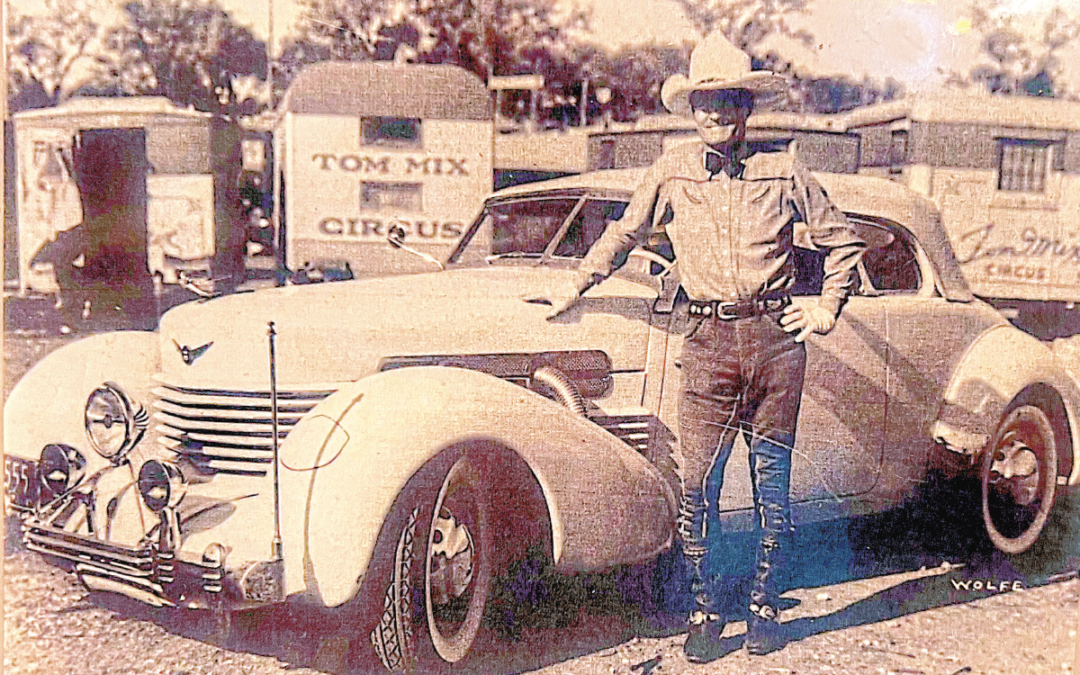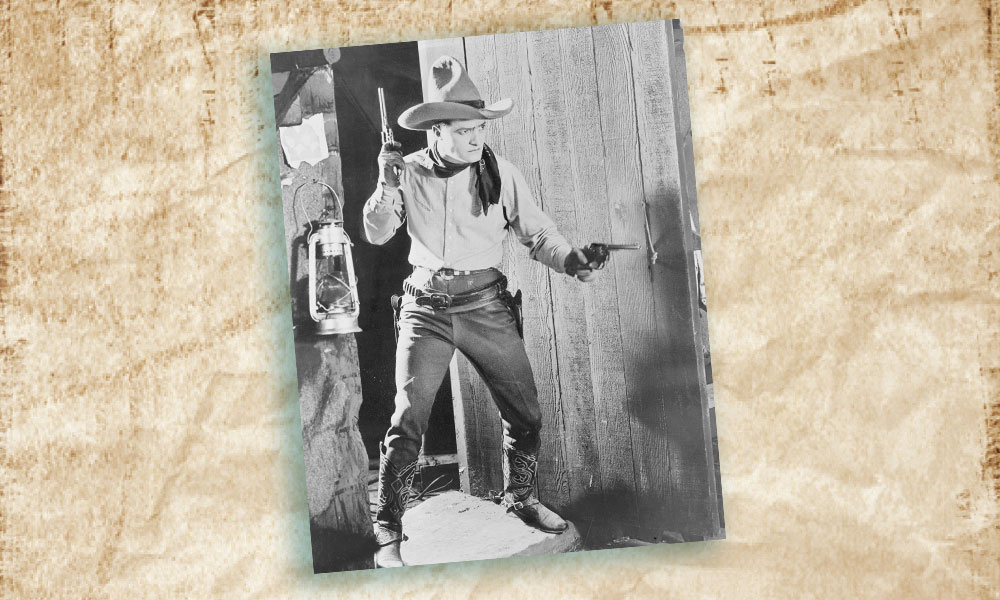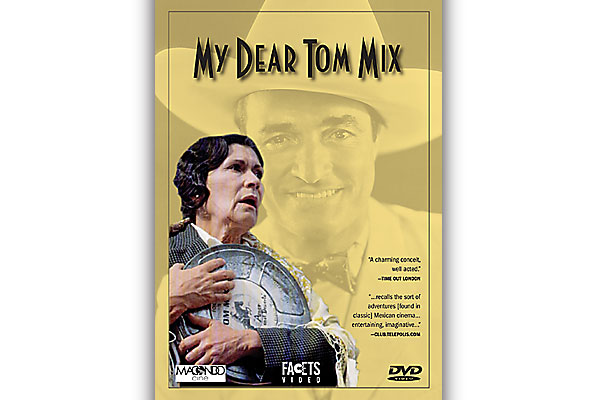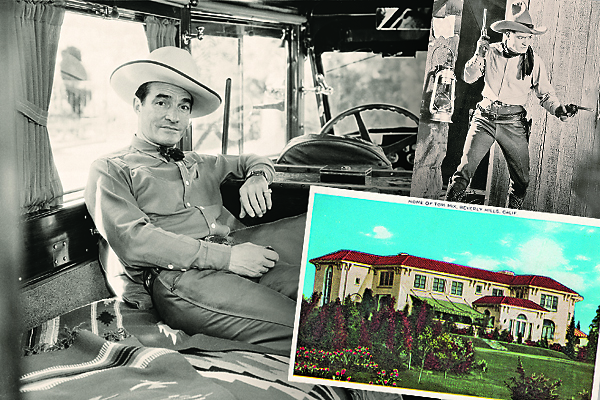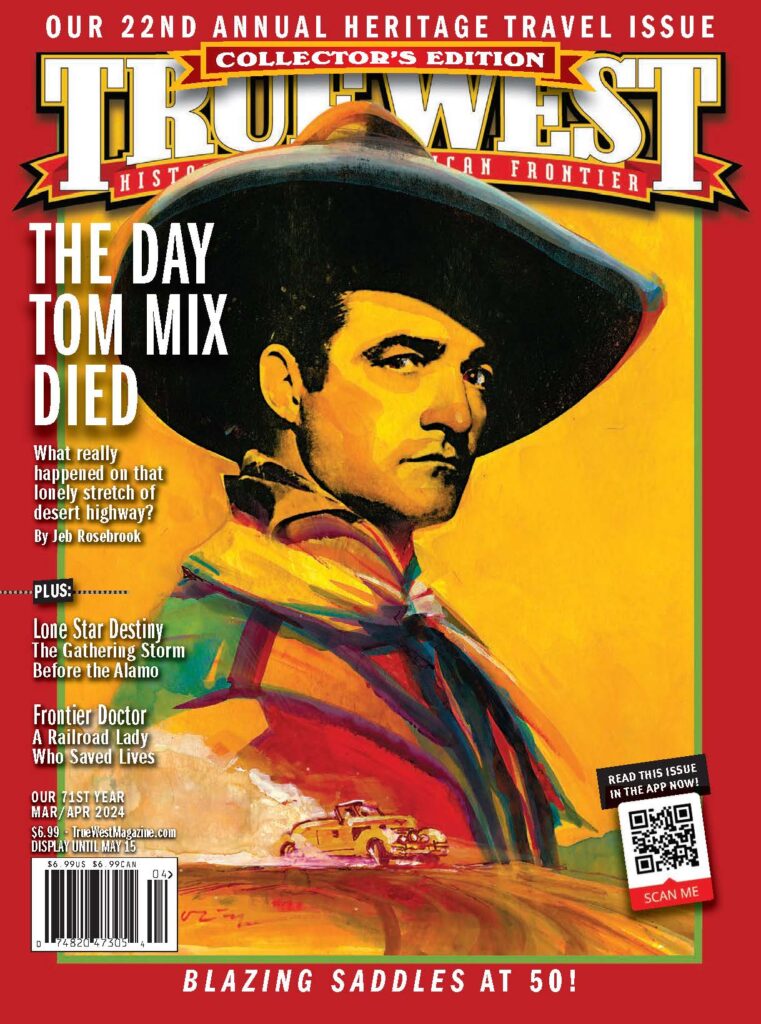What really happened on that lonely stretch of highway?
Tom Mix had the pedal to the metal on his bright-yellow Cord Phaeton sports car as he barreled along the dirt road from Oracle Junction toward Florence, Arizona. He was in the midst of a cross-country driving tour, and he had big plans for recharging his flagging circus and movie career. Mix had the supercharged Cord at 80 miles an hour and his siren blaring that Saturday afternoon when he passed two Midwestern boys driving north on the unpaved stretch of U.S. Highway 80-89. The promise of the day—and the future—lay ahead of him across the beautiful desert.

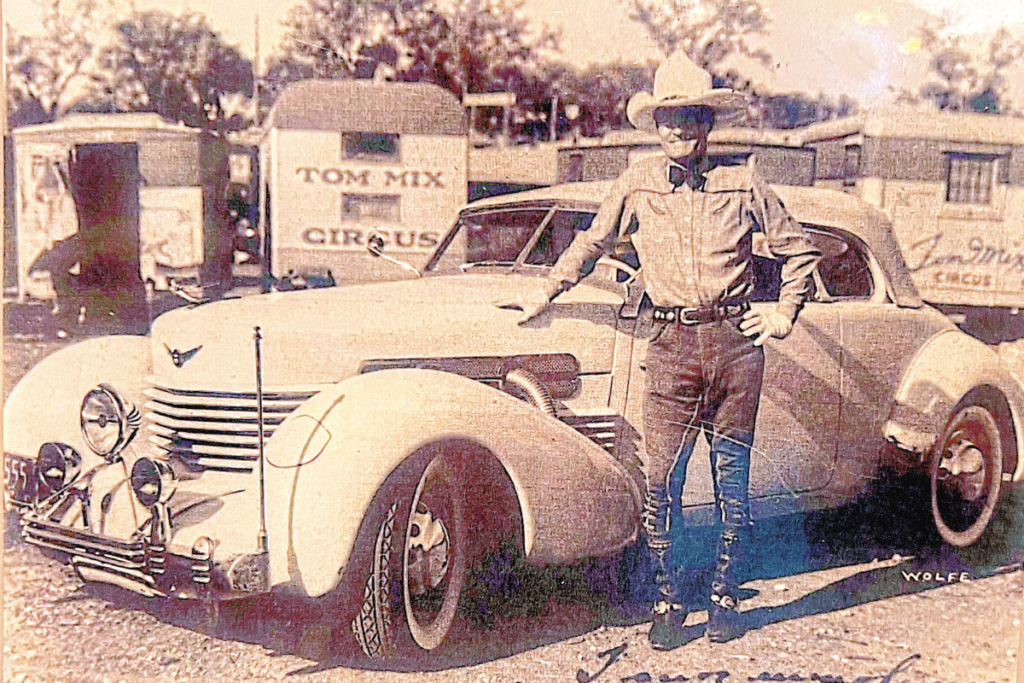
Courtesy Bob White Collection

The First Superhero
According to Arizona historian Marshall Trimble, Tom Mix was “America’s First Superhero.” “Mix’s movies were pure frolic and delight,” says Trimble. “He was the man in the white hat who rode into town and battled the bad guys. The films were loaded with fistfights, slapstick stunts and pretty ladies, and to the relief of his adolescent fans, Mix seldom rode off into the sunset with any of them.”

By 1917, the Pennsylvania- born Western star was contracted to Fox Studios in Hollywood. Mix eventually made over $17,000 a week, lived in a custom-built Beverly Hills mansion drove fast, expensive cars, including a 1927 Rolls-Royce Phantom 1. He and his wonder horse Tony were international box-office stars of the silent screen, and before the introduction of talking pictures and the stock market crash in 1929, Mix’s fame and fortune seemed to have no end.

Humble Roots
So how did the boy from Mix Run, Pennsylvania, become the most world-renowned Western actor?
Like many American celebrities before and after the superstar cowboy hero, Mix rose to fame on a recipe of audacious courage, serendipity, luck and talent. It was anything but easy, but Mix never liked doing anything easy, as he proved again and again in his action-filled pictures. As Gene Autry once said, “Could anyone have written a character more colorful than Mix?”
Mix’s life story started on January 6, 1880. He was the third of four children of Edwin and Elizabeth Mix. His father managed the stables for a local family, and Tom took to horses at an early age. In 1898, he volunteered for the Army, hoping to see action in the Spanish-American War. Instead, he served at a series of posts in the East until 1902, when Sgt. Tom Mix, recently married to Grace Allin, drove away from his post at Fort Monroe, Virginia, and never returned.

Westward Ho!
The AWOL soldier went to the Indian Territory and didn’t return to the East until he rode in President Theodore Roosevelt’s inaugural parade in 1905. By that time he was on wife number 2, Kitty Jewel Perrine, and was honing his cowboy skills as a hand and performer with the famous Miller Brothers 101 Ranch in Guthrie, Oklahoma. According to Mix authority Jeff Arnold, “One of his duties was telling ‘windies’ to gullible tourists, and tall tales became part of his repertoire.” Mix’s own storytelling and that of overeager publicists created for the fearless Mix an imaginary and overly heroic military and law enforce-ment history that has been well-repeated during the eight decades since his passing.
Divorced from Perrine in 1906, the single, fun-loving cowboy went West in 1909, to test his riding, roping and rodeo skills in the Prescott, Arizona, Frontier Days Rodeo. His cowboy skills soon caught the attention of a young Hollywood producer, William Selig, who would make Tom Mix a star. Also in 1909, a red-letter year for the cowboy, Mix fell in love with and married his third wife, Olive Stokes.

Fearless and Bold
Mix’s first picture for Selig Polyscope was The Cowboy Millionaire. From 1909 to 1917, the boy from Mix Run starred in over 236 Selig pictures, many made on location in Oklahoma, New Mexico and Arizona.
In 1913, Mix starred in his first Prescott, Arizona, Western for Selig. He was the villain “Apache Frank” in The Sheriff of Yavapai County. He and Olive were also the grand marshals of the annual Frontier Days Parade, and he won the first steer-riding event ever held at the rodeo.
Soon he was ready for the spotlight and the production company sent him to California to get more experience. In 1915, the actor returned to his beloved Prescott, where he made another 30-plus Westerns for Selig Polyscope. His home was the Bar Circle A Ranch (today’s Yavapai Hills).
After Prescott, Mix went on to be a big star for Fox Film Corporation, but he never forgot his “hometown” and its famed Fourth of July Frontier Days, returning in 1920 to film the rodeo for scenes in his film The Texan.
Did Tom Mix Actually Make the Jump?


This photograph is very controversial. Some say it has been faked, while others say the stunt was actually done and captured on film. (The film has been lost, but one author claims he has seven frames of the contentious jump.) One faction asserts that a stunt double did the jump. Others say Tom would never have stood by while someone else did it for him. I agree with that! Still, to my eye, it seems a little too good to be true—horse and rider seem a tad small for the scale—but more than a few historians believe the two—Tom and Tony—actually made the jump. Whether it was faked, or not, one thing is certain: Tom Mix was famous for actually doing hairy stunts that were every bit as ridiculous. And, it was that very personality trait and attitude that later got him killed. —BBB
“The Old West is not a certain place in a certain time, it’s a state of mind. It’s whatever you want it to be.” —Tom Mix
You’ll Never See Tom Mix Again
On Columbus Day, October 12, 1940, the sun came up over Tucson, Arizona, where Tom Mix was a guest of the Santa Rita Hotel, a favorite of his. According to The Arizona Star, the film star was in town for “one of his periodic visits to the Old Pueblo.” The weather was cool in the early morning hours, fair and sunny. The desert would warm to chamber-of-commerce 80 degrees. Mix must have welcomed the warmth and the promise of a beautiful drive north in his convertible sports car. He was rebuilding his career in film and circuses, and the cool, dry desert morning held the promise of a good day ahead. He needed it.


Swinging on a Star
Twenty years before Tom Mix loaded up his supercharged Cord for his fateful drive north from Tucson to Florence, the Western hero was one of the highest-paid movie stars in the world. In the mid-1920s he built his opulent Beverly Hills mansion for his fourth wife, Victoria Forde, and their daughter, Thomasina. Mix was under contract to Fox Studios, and in 1924 he made The Heart Buster, his 50th feature for William Fox, which, The Oakland Post Enquirer reported, “establishes a production mark which stands unequalled in the history of the photoplay. Making this record the more remarkable, Mix has never made a failure.”

During the Roaring Twenties, the actor was always working, starring in more than 160 films. He even built a 12-acre set at Fox’s Edendale lot in Los Angeles; he dubbed it Mixville. In 1928, after a dozen years under contract to William Fox, Mix left the studio that made him a millionaire many times over. Critics were bored with his pictures, and Mix sought greener pastures. He was desperate for good reviews and signed for half his usual salary with Joseph Kennedy’s FBO Pictures. Kennedy and Mix were not a good match. He made five low-budget films, the last of which he completed in January 1929, the same month he was a pall bearer at Wyatt Earp’s funeral. He would not make another movie for three years.

Under the Big Tent
Tom Mix was unequivocally the Western king of silent films. But when talkies took over the in the late 1920s, Mix was not ready to adapt to the new medium. He was a showman; he loved the adulation, the roar of the crowd and the moviemaking style he had enjoyed for two decades. And he loved the exhilaration, the adrenaline of the stunts. He was a born thrill-seeker who was unafraid of putting himself in harm’s way for the good of the picture. But Mix was famous for drawing the line in the sand when it came to his heroic onscreen image: he would not lose a fight (he did once, and never did it again), he would not ride off into the sunset with the girl and he would not play guitar and sing. Ever!

From 1929 to 1932, Tom Mix toured with the Sells-Floto Circus. Life on the road, under the Big Top, should have been the best of times for the Western star. But in 1929, his fourth wife Victoria couldn’t stop spending money; the IRS accused him of tax evasion; and in October the stock market crashed. Mix was nearly bankrupt. Only his reported $15,000-a-week salary from the circus kept him afloat—but that wouldn’t last.

Straight Shooting
In 1932, Tom Mix again heeded the siren call of the silver screen and marriage. He had divorced Victoria in 1930, then met and married his fifth and final wife, Mabel Hubbell Ward. Universal Pictures’ Carl Laemmle offered him a deal that would make him their top Western star in talking pictures. While back in the saddle, making horse operas for Universal in the San Fernando Valley, Ralston Purina made a deal with the Western hero to lend his name to a new radio series, Tom Mix Ralston Straight Shooters. The show debuted on NBC radio on September 25, 1933. The shows were 15 minutes long and aired three times a week. The show was broadcast worldwide, and his young fans joined the Straight Shooter Club by the millions. Ralston even created a Sunday morning comic strip that sold Ralston’s Shredded Wheat Chex and Tom Mix comic books.
Mix’s experiment with talking pictures ended in 1935. His body was tired, and old injuries from nearly 30 years of doing his own stunts had caught up with him. Mix left Universal after a year, bone-weary, tired and sick. He turned back to the circus. Mix was soon touring under the banner, Tom Mix Wild West and Sam Dill Circus (Combined). The entertainer was now in control of his own destiny. In February 1935, Dill died, and Mix bought out his heirs. In need of fast cash, Mix made a deal with Mascot’s Nat Levine for a 15-part serial. He would be paid $40,000 for four weeks’ work. The Miracle Rider would be his only serial and final work on celluloid.


King of the Cowboys
From 1935 to 1940, Mix focused all his time and finances on his Tom Mix Circus and Wild West. The Ralston Straight Shooters radio program was popular across the U.S. and Canada and could be heard on shortwave radio broadcasts overseas. In the late 1930s, Mix fought alcoholism, smaller crowds and financial hardships. He faced lawsuits from his fourth wife, Victoria, and money was a constant problem. After a dismal summer circus season of 1938, Mix went with his horse Tony and two other performers to England in September for a 20-week tour. Later, he signed with the famous Danish troupe, Circus Belli, which he toured with in Europe in the summer of 1939.
And then the war broke out on September 1, 1939.


The Mystery of the Warning Signs
Why did Tom Mix not see the barrier and road signs?
Washed Up and Washed Out
Western pulp writer Walt Colburn wrote up the death of Tom Mix for our sister publication, Frontier Times, and he described the death scene this way: “Tom Mix owned a flashy looking Cord that he drove with the top down. The rear seat held his luggage, including a locker trunk. A highway crew was working on the Florence highway and they had put up a barrier with a detour sign. Tom Mix, traveling eighty miles an hour, had smashed through the barrier, turning the Cord over in a dry wash. The heavy trunk had been dislodged with the sudden impact, striking Tom on the back of the head and breaking his neck. He was killed instantly.”
Of course, Colburn was not there and got his information from a friend who also was not there. Although basically accurate, two things jump out at me. The first is, why would Tom Mix blindly drive through a “barrier with a detour sign” without slowing down? And, two, we now know the “heavy trunk” was actually a medium-sized aluminum suitcase—made by Halliburton!—and it is in the Tom Mix Museum in Dewey, Oklahoma.


Impaired? Or Drunk?
We know that Tom Mix visited with Walt Colburn and Pima County Sheriff Ed Echols at Colburn’s Catalina Foothills ranchito on the outskirts of Tucson on the day before the accident. In the Frontier Times article, Colburn describes the King of the Cowboys sipping whiskey and trading stories with his two old friends. That night, Mix reportedly gambled and drank until 3 a.m. with Santa Rita Hotel musicians. He left Tucson around noon the next day, October 12, drove north on Oracle Road and stopped at Oracle Junction (near the present-day Lupe’s Restaurant) and allegedly played poker and drank whiskey at a roadside establishment before driving off to his appointment with the washed- out roadway south of Florence. Invariably, when a famous person dies, local legend grows up around the event with everyone remem-bering him stopping at their place of business and enhancing the encounter with tales of playing cards and drinking. I’m not saying it didn’t happen, but I am saying I take some of these “remembrances” with a grain of salt. That said, it is probably safe to say Mix had a few nips of whiskey before he took the highway to hell. How high was he? Maybe high enough to ignore the detour signs. And let’s be honest, it’s hard to read distant road signs at 80 miles an hour, no matter how much you have had to drink.
One of the local newspapers gave this account: “He was driving so fast that he didn’t notice—or failed to heed—signs warning that one of the bridges was out on the road ahead.” A small highway crew was working on the bridge at the time of the accident. John Adams of Oracle claimed that after the car overturned, Adams saw a figure move from beneath the Cord and start to stand up. Mix supposedly took a step and fell dead.

This very old saguaro stands—with arms down—almost in somber tribute, pointing to the spot where Tom Mix died. It witnessed the wreck in 1940 (see car on current bridge in background).

Several minutes after the crash, Martin Younkers, of Beloit, Wisconsin, and Anthony Monts of Rockford, Illinois, drove up to the crash site from the south and helped pull the actor’s body from under his racing car. They had been passed by Mix on the dirt road, and they reported Mix used his siren to pass them at a high rate of speed. Yonkers and Monts also claimed a heavy suitcase had fallen against Mix’s head, burying his face in the soft sand.
If there was a barrier, it must have been hard to see from a distance. And perhaps it created an optical illusion, with the rebuilt bridge abutments below the roadway making it appear as if the road was unobstructed, and therefore unable to be seen by Mix in the speeding roadster.
In the end, drunk or sober, signs or no signs, The King of the Cowboys was dead. He had cheated death numerous times in his long career, and it’s more than a little ironic that this anonymous wash, one of thousands that crisscross Arizona’s roadways, had finally claimed “The Road Demon.”


The Day Tom Mix Died
On Sunday morning, October 13, 1940, newspaper readers around the country learned of Tom Mix’s death in the Arizona desert the day before. He lived fast, and he died fast, and the world mourned. And while Mix’s demise at the wheel of his Cord sports car in an unnamed Arizona wash made front page news across the United States and in London, England, Mix’s crash was hardly the most important news of the day. Germany, Italy and the USSR were still dividing up Europe, and Japan was making war on China. Even Mix had a premonition of the future after he returned from Europe near the end of summer in 1939. Speaking to a group of reporters in Binghamton, New York, on September 24, 1939, he told them “This war is mean business. I don’t know how Germany can be stopped,” Mix was quoted while on a short stop at the Lackawanna station. “The Nazis show unbelievable power already.”

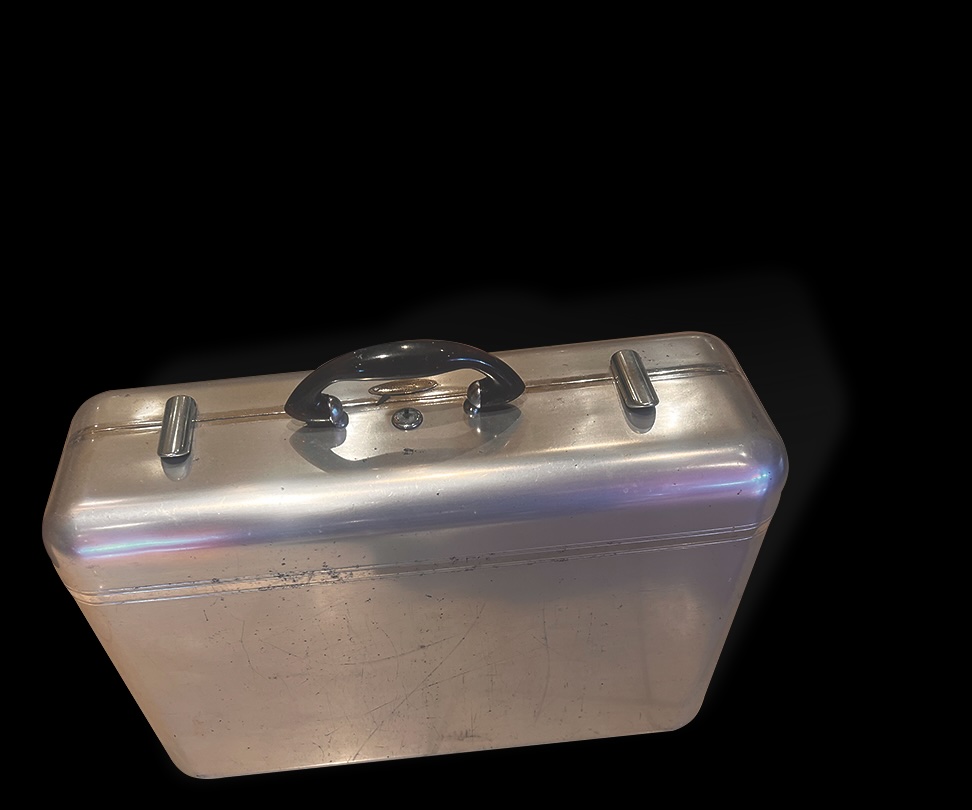
Courtesy Bob White Collection
Headlines of the Day
“British Blast Nazi Bases/Germans Enter Bucharest,” Arizona Republic, Phoenix, AZ
“Total Defense of Hemisphere is Aim of FDR,” The Arizona Daily Star, Tucson, AZ
“Battle Waged by Flotillas Off Coast of Britain,” Brooklyn Eagle, Brooklyn, NY
“FDR Warns Japs U.S. Will Continue Aid,” The Pampa News, Pampa, TX
“German Attacks on London Are Lightened,” Journal and Sentinel, Winston-Salem, NC
“Nazi Troops Occupy Bucharest,” Los Angeles Times, Los Angeles, CA

“Greece Will Fight Axis if Invaded,” The Independent Record, Helena, MT
“U.S. Navy and Air Force Pledged by President for Western World Defense,”
The Bellingham Herald, Bellingham, WA
“Poll Reveals Gain for G.O.P./Nation Arming Only For Peace Says Roosevelt/Wilkie Blasts New Deal for Defense Delays,” Chicago Sunday Tribune, Chicago, IL
“Roosevelt Defies Dictators To Halt U.S. Sending Supplies to British,”
Miami Daily News, Miami, FL
“U.S. Works for British-Russia Friendship As Nazis Tighten Grip on Balkans,”
Sunday Dispatch, London, England
“Roosevelt Sounds New Warning to Axis Powers,” Albuquerque Journal,
Albuquerque, NM
“Nazi Flag Goes Up in Rumania/Draft Setup is Revealed on Big Island/Aliens Warned to Register” Hilo Tribune Herald, Hilo, HI

